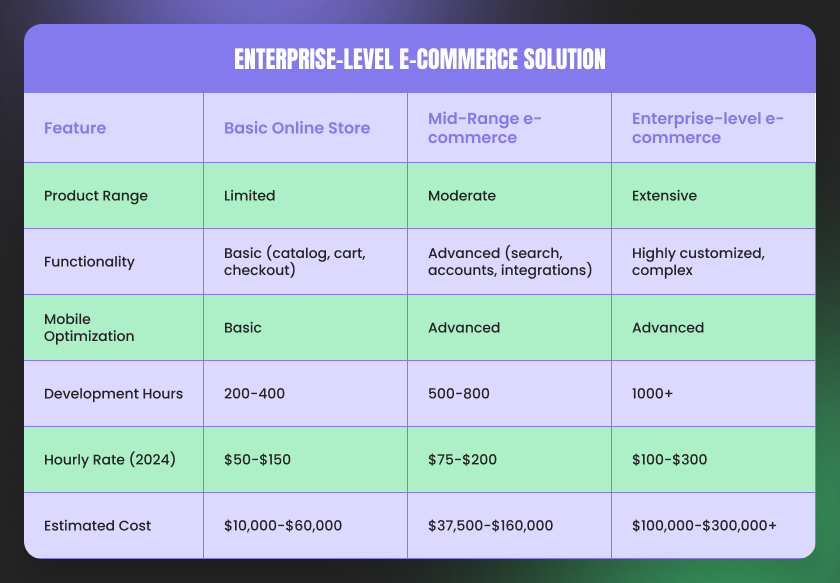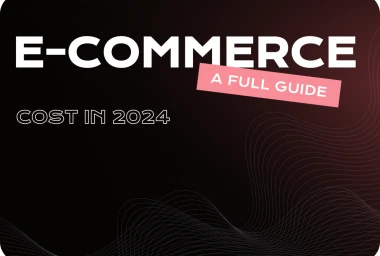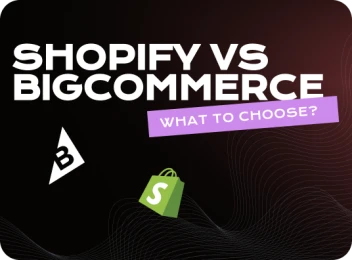In 2024, the e-commerce environment is still progressing with high growth rates, and more and more companies are switching to online selling to satisfy customers’ requirements. E-business is becoming more popular because of mobile marketing with consumer electronics, decision-to-consumption time, differentiation of shopping experiences, and improved payment gateways.
This means that firms are willing to allocate more resources to enhance and improve their e-business strategies to counter their rivals. Many authors believe that as of 2024 there will be 2.71 billion internet users globally with 57% of them shopping online. That is approximately 33% of the total world population that buys things online, which has grown by a 7% rise this year as compared to the same period in the last year. So, if you decide to develop an e-commerce app, what can affect its price?
Factors Influencing E-commerce Development Costs
While overall online shopping competition increases, and customer expectations grow, several factors are likely to affect the development cost. Some of the essential parameters affecting the cost include the extent of the project and the chosen platform, as well as the capabilities of the development team. Technological and market factors in 2024 make it even more crucial to assess these factors to keep e-commerce cost-efficient and capable of handling demands for growth and users.
Scope and Complexity of the Project
Thus, the size and the level of detail of an e-commerce project define the costs of its development. A minimalistic store that comes with a bare-bone product list and no-frills checkout option will be far more affordable than one that has advanced features, like multi-location inventory, tiered pricing, or recommendation engine.
Basic vs. Advanced Features
For instance, if it is a fundamentally average e-commerce site then it will include only the following fundamental features – easy-to-utilize product list with basic navigation control, easy-to-integrate security and payment gateway, and account creation. An advanced platform can have recipient-based shopping experiences, and tiered pricing models, and can integrate external tools such as shipping cost estimators or CRM instruments.
Pages and Integrations
Other factors are the size of your website and the number of integrations, among other things. The cost of setting up an e-commerce store will be different depending on the number of product pages you have such as less than 500 categories, variations, and product descriptions. Furthermore, working with multiple third parties for example payment gateways, ERP systems or marketing automation increases the time of development as well as the costs because these third parties have to be incorporated and interfaced with, which takes time and testing.
Open-Source Platforms
Some of the most commonly used platforms that are more open-source in nature like Magento and WooCommerce are cheaper in the initial investment as the software is usually available for free. However, these platforms demand more implementation and maintenance as compared to the other types and can be expensive when it comes to their development. Businesses also have to consider the need to host, secure, and other plugins that they may require to meet their needs.
Although there is much freedom and more control with such open-source platforms as mentioned, they are usually not as user-friendly and can entail a lot of costs when it comes to developing from scratch or even having to look for patches for security issues, or looking for ways to fine-tune the performance of their platforms.
Proprietary Solutions
Examples of such solutions include Shopify and BigCommerce and since most of them are paid solutions, they are often easier and faster to implement compared to Open source solutions and ideal for smaller businesses or those who prefer ease of installation. These provide hosting services and security as well as frequent updates, but they are usually paid every month and also they normally take a certain percentage of the sales that are made.
As it is with most closed-source applications, there may be less flexibility in the design and functionality in comparison to open-source platforms; although this may not be ideal for business requirements, they may be cheaper to install as compared to open-source ones.
Custom-Built Solutions
There is also the option for a business that requires having full control of its online shopping experience to have a Custom-Built e-commerce Solution. However, this is the most costly because the platform has to be developed afresh from scratch. Custom development allows businesses to produce exclusive features and capabilities at the same time, it requires more capital to invest in the beginning as well as more capital to sustain over time.
These types of solutions are most appropriate to companies that need particular software to be tailored to the business’s needs or to those companies that can afford to be different from others in a market.
In-House Developers
The main benefit of the in-house team is that you will have specialized developers who work exclusively on your project. This option means more control and involvement which is, however, costly as compared to the previous option. It makes sense that in-house developers should receive full-time wages, medical and other benefits, as well as professional training which in the long run, may not come cheap. However, attracting and building a team with the right skill set to accommodate all the requirements stated above may be cumbersome and costly, particularly for small-scale businesses.
Outstaffing
Outstaffing can allow you to get talent from specialized agencies for their project but with certain flexibility that is not available when one hires a regular employee. This makes it easier for business entities to adjust resources in terms of quantity in line with the demands of particular projects implying flexibility as well as economy of scale. Outstaffing sometimes encompasses highly skilled professionals with diverse experience, which might be crucial for the successful implementation of intricate e-commerce solutions.
Depending on the partnership price ranges between the cost of having internal teams and freelancers but the advantage with outstaffing is there is an experienced project manager and QA in the process.
Freelancers
Freelancers are advantageous in that they usually charge at a cheaper rate compared to firms, especially for businesses that do not have large budgets or for small tasks. Therefore, while achieving some of these benefits, there are some drawbacks, especially in availability and reliability. Some of the challenges that freelancers face include inadequate equipment, finances, schedules, and a network like that of an agency or in-house team while working with an aggregator of freelancers communication can be a problem and can lead to time delays.
However, using freelancers is more suitable when you have many tasks that are delimited; if you give a large-scale e-commerce project to only freelancers, the final product may differ from what you expect, or the development may take longer.
Experience and Technical Expertise
Whichever model of team composition a client chooses, the experience and technical skills that developers bring to the table add significant value to the success of a project. In this respect, outsourcing a team with extensive experience in developing e-commerce systems ensures adherence to best practices, early resolution of potential problems, and the creation of a scalable and secure platform.
This means that an experienced team will also fully understand the integration of essential features that are critical to the smooth delivery of your service, such as payment gateways, mobile responsiveness, and data security. While more experience may put them in a higher price bracket, their product will be well-functioning, scalable, and secure, helping to reduce costs in the long run.
Cost Breakdown by E-commerce Project Type
Different e-commerce projects will have different cost structures due to the complexity and demands they place on a client. Understanding how each type of e-commerce platform is priced will go a long way to helping businesses budget more appropriately and make informed decisions based on their very specific needs. Here is an estimated cost and breakdown of hours for different e-commerce project types in 2024.
Basic Online Store:
A small business with a limited range of products will need a basic e-store with minimum functionality: usually a product catalog, shopping cart, and secure checkout. This class of project will also include basic mobile optimization but will exclude advanced customization or integration. Development typically takes 200 to 400 hours, depending on the specific needs and complexity of the store design. In 2024, the hourly rate for developing a basic online store was approximately $50 to $150 per hour, depending on location and the expertise of the development team. This brings the estimated total cost to around $10,000 to $60,000.
Mid-range E-commerce Platform
Mid-market e-commerce would require more advanced features such as sophisticated product search, customer accounts with order history, and multiple integrations with third-party systems such as inventory management, CRM, or marketing tools. It may also have advanced mobile responsiveness and multi-currency or multi-language support. Because of the richer feature set and integrations, it is assumed that development for a mid-tier platform would typically take 500 to 800 hours. Normal hourly rates in 2024 would be between $75 and $200 per hour. This puts the project estimate at $37,500-$160,000.
Enterprise-level E-commerce Solution:
The enterprise-level e-commerce solution is aimed at large businesses that require customized features, multiple third-party integrations, and very high scalability. Most of these platforms have large inventories, complex workflows, and advanced analytics. In addition, enterprise-level solutions should be able to handle very high traffic loads and provide a seamless experience across many geographies or platforms. Dynamic pricing is a feature that could be attributed to all of this, complemented by customized checkout flows and advanced security measures.
With this level of sophistication and customization, an enterprise solution typically requires more than 1000 hours of development. In 2024, the estimated cost of an hour of work on an enterprise-level project will vary between $100 and $300 per hour, so the final estimate for such a system will be between $100,000 and $300,000, or even higher depending on the scope and scalability requirements of the project.
Still, let’s make it a little easier to understand. That’s why we’ve made this comparison table specially for you:

Hidden and Ongoing Costs
In this case, two main issues come to mind: First, development costs of applications are usually high during the initial stage of their development and second, there are always many hidden and recurring costs that may affect the overall budget. These costs are usually incurred after the initial launch and may affect the future profit of the e-commerce platform. It is important to be aware of these costs to keep your store running optimally, protected, and efficiently. Below is a rundown of some of these unfamiliar and continuing expenses linked with e-commerce projects in 2024.
Maintenance and Support
Additionally to the creation of an e-commerce platform, support and further development of the platform represent key factors for success in the area of e-commerce. Maintenance relates to operational processes that aim at updating the system and fixing bugs and threats that may pose a threat to the efficiency of the platform given the ever-evolving technological advancements. Mandatory, non-discretionary service costs may also be required for these services depending on the sophistication of the platforms and services required. Regularly billed hourly, monthly, or yearly charges for maintenance and support normally cost anywhere between a few hundred dollars to a few thousand dollars, depending on the service provider and the options included in the support plan.
Hosting and Infrastructure
Choosing the right hosting provider or cloud service is essential for ensuring that your e-commerce platform runs smoothly. Costs for hosting can vary significantly based on factors such as the type of hosting (shared, VPS, dedicated, or cloud), storage needs, and the level of performance required. Additionally, traffic volume can impact hosting costs; higher traffic typically necessitates more robust and expensive hosting solutions to handle the increased load and ensure optimal performance. Businesses should anticipate these costs as part of their budget to avoid unexpected expenses related to traffic spikes or increased storage needs.
Security Measures
Selecting the most suitable hosting provider or cloud service is crucial for the proper functioning of your e-commerce platform. Different types of hosting include shared, VPS, dedicated, and cloud hosting, and hosting may be based on different parameters such as storage requirements and performance level. Also, the traffic level can affect the cost of hosting; if the traffic is high, the hosting needs to be upgraded and will, therefore, be costly to handle the traffic load and provide the best services. These costs are almost fixed costs and should be planned for by the businesses they should not be a shock when traffic increases or data storage becomes an issue.
Payment Models
It is so vital to select the most appropriate payment model once a company is to embark on an e-commerce development project. Now, let us turn to the payment models: there are two basic types, namely, fixed-price and time-and-materials (T&M). Both have their benefits and drawbacks and knowing about such is equally beneficial to anybody in the position of deciding between one or the other based on the needs of a specific project.
Fixed-price
In the fixed-price contract structure, the price is predetermined before work begins on the project. This price and cost is not just the simple projection of the projected length of the project but it is more of the project scope, period, and identified outputs. The client pays a fixed price for the services for the work to be done or materials to be supplied without consideration for the number of hours spent on items used. This model is well suited for projects that are characterized by a well-defined scope of the project and where the requirements may not undergo substantial change in the foreseeable future. It provides cost predictability and is best suited for small-scale development or where a client needs to know how much they would be spending from their budget.
A contract at this level offers more control of the price and allows one to avoid fluctuations in costs. It can also involve some form of setting targets or periodic payments or structures, which are usually tied to the delivery of a particular project. However, If project requirements change or new complications appear then the fixed price has problems with workload within the agreed price, which lead to disputes or re-negotiation. They also fear that developers will give unbelievably low bids for the contract in a bid to win it; this could also mean compromising on quality.
Time-and-materials (T&M):
This is a contract where the client hires the contractor based on time and material which simply means that the client will have to pay for the time spent on the project and all the materials used in the course of the project. Hou’s are charged at a rate agreed from the hourly rates with the resources utilized and are normally billed at agreed rates of invoicing. This model is best used in projects where the specification keeps changing or when they are not sure of what comprises the project. It enables change and adaptations throughout the process of development.
T&M provides the ability to flex around what may be required and include changes, enhancements, or otherwise during the work. This is helpful in a complex project or innovative kind of project where exact requirements may not be known in advance. However, since the budget is not fixed in T&M projects, increased costs come up when the scope of a project grows or development takes longer than predicted. You need effective communication and regular updates so that all can work in the area of cost management to avoid overrunning the budget.
Covent IT E-commerce Development Budgeting Tips for 2024
E-commerce development can get confusing, especially with the rapid changes burping in 2024. However, to make sure that your project stays within your budget and meets your business objectives, here are some professional tips on how to budget for such a project from Covent IT:
1. Define Clear Objectives and Scope
Define your project objectives and scope first. Understand what features and functionalities are essentially required on your e-commerce site. A well-defined scope would not allow scope creep, making sure that both you and the development team have the same view of the project so that any unwanted cost could be avoided.
2. Choose the Right Payment Model
Identify an appropriate payment model that best suits your project needs. The fixed-price model provides cost certainty if you have a well-defined, fixed scope. In projects where requirements continue to evolve, the time-and-materials model offers flexibility but requires careful management to prevent cost overruns.
3. Budget for Hidden Costs
Add to those the unaccounted-for expenses: ongoing maintenance, hosting, and security. Such recurring expenses are just what your e-commerce needs to be kept running securely. Set part of your budget aside for such ongoing needs and don't get surprised come later.
4. Invest in Quality Development
While the temptation to save money by hiring the cheapest developers is there, investing in a high-caliber development team saves you money in the long run. The more experience developers have, the stronger, more scalable, and secure your platform will be, thus reducing the need for fixes or updates that can be expensive later on.
5. Plan for Scalability
Think about scalability when budgeting for your e-commerce platform. Invest in scalable solutions that will be able to handle more traffic and larger transactions once the business starts to grow. This saves you from the hassle and expense of an overhaul or performance issues once your site starts growing.
6. Prioritize Security
Security is considered one of the most vital issues of e-commerce websites. Your website needs to be secure from data breaches and fraudulent actions. In this respect, one needs to make a budget plan for SSL certificates, data encryption, and compliance with standards of payment security to safeguard the business and earn customers' trust.
7. Review and Adjust Your Budget
During the actual project implementation, keep an eye on the budget and be prepared for changes at any moment in time. Such frequent reviews will offer early warnings against possible cost overruns for appropriate remedies before the situation can get out of hand.
Conclusion
Yeah, there are several factors for the successful implementation of an e-commerce project in the year 2024. You’ll have to deal with project scope and complexity, the selection of appropriate platforms, and the best payment models to use in budgeting. Each of these elements is important and forms the general cost and effectiveness of your e-commerce platform. Moreover, as you can realize, by focusing on outstaffing with secure and scalable solution provisioning, you'll make sure that the project will be done with the highest quality and efficiency standards.








